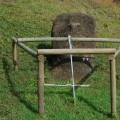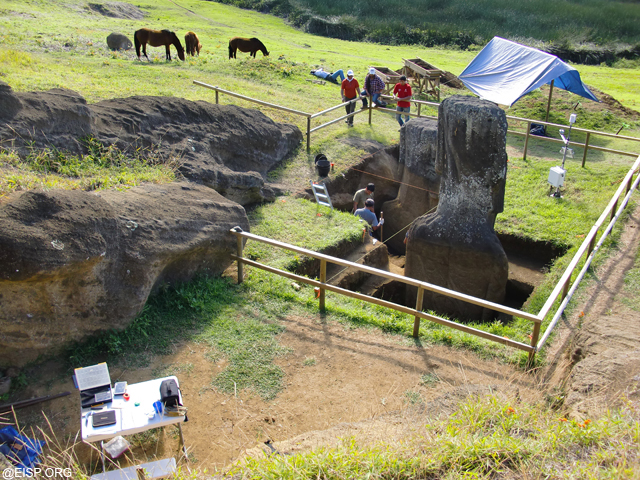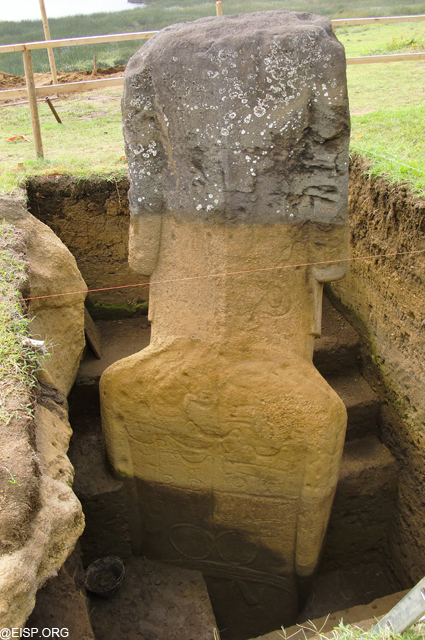Post by brillbilly on Feb 2, 2010 7:58:39 GMT 10
some pictures that most dont see of easter island ;D
![]()
images.travelpod.com/users/skcoll/worldtour2005.1115192700.imgp1697.jpg[/img]
![]()
images.travelpod.com/users/skcoll/worldtour2005.1115192700.imgp1704.jpg[/img]

[






even more perplexing mysteries have begun to surface from the research of scholars outside the boundaries of conventional archaeology. As previously mentioned, orthodox archaeologists believe that Easter Island was initially settled sometime around 318 AD by a small group of Polynesians lost on the open sea. Other scholars, however, have suggested that the tiny island may have once been part of far larger island and that the original discovery and use of the site may be many thousands of years earlier in time (it is known, for example, that Melanesians were journeying around the Pacific in boats as early as 5500 BC).
Three researchers in particular, Graham Hancock, Colin Wilson and Rand Flem-Ath, believe that Easter Island was an important node in a global grid of sacred geography that predates the great floods of archaic times. Easter Island, writes Graham Hancock, is
“part of a massive subterranean escarpment called the East Pacific Rise, which reaches almost to the surface at several points. Twelve thousand years ago, when the great ice caps of the last glaciation were still largely unmelted, and sea-level was 100 meters lower than it is today, the Rise would have formed a chain of steep and narrow antediluvian islands, as long as the Andes mountain range.”
At that time, the land we now call Easter Island would simply have been the highest peak of a much larger island. The fascinating question posed by Hancock, Wilson and Flem-Ath is whether this much larger island had been found and settled long before the ‘318 AD discovery’ date assumed by orthodox archaeology? (In reference to the notion of a so-called ‘Ice Age,’ it is important to mention that scientists from a variety of disciplines including geology, climatology, zoology, paleoanthropology, oceanography, geophysics and mythology have begun to question the hypothesis of an ice age and glacial coverage that was first proposed by Charles Lyell and Louis Agassiz in the early 1800’s. Readers interested in learning more about the possible non-existence of the Ice Age and its glacier coverage will enjoy the book Cataclysm: Compelling Evidence of a Cosmic Catastrophe in 9500 BC, by Allan & Delair.)
Besides its more well known name of Rapa Nui, Easter Island is also known as Te-Pito-O-Te-Henua, meaning ‘The Navel of the World’, and as Mata-Ki-Te-Rani, meaning ‘Eyes Looking at Heaven’. These ancient names, and a host of mythological details ignored by mainstream archaeologists, point to the possibility that the remote island may once have been a geodetic marker and the site of an astronomical observatory of a long forgotten civilization. Speculations about this shadowy antediluvian culture include the notion that its mariners had charted the world’s oceans, that its astronomers had sophisticated knowledge of long-term astronomical cycles such as precession and cometary orbits, and that its historians had records of previous global cataclysms and the destruction they caused of even more ancient civilizations. theunexplainedmysteries.com/easter.html
;D not that easy to explain
images.travelpod.com/users/skcoll/worldtour2005.1115192700.imgp1697.jpg[/img]
images.travelpod.com/users/skcoll/worldtour2005.1115192700.imgp1704.jpg[/img]

[







even more perplexing mysteries have begun to surface from the research of scholars outside the boundaries of conventional archaeology. As previously mentioned, orthodox archaeologists believe that Easter Island was initially settled sometime around 318 AD by a small group of Polynesians lost on the open sea. Other scholars, however, have suggested that the tiny island may have once been part of far larger island and that the original discovery and use of the site may be many thousands of years earlier in time (it is known, for example, that Melanesians were journeying around the Pacific in boats as early as 5500 BC).
Three researchers in particular, Graham Hancock, Colin Wilson and Rand Flem-Ath, believe that Easter Island was an important node in a global grid of sacred geography that predates the great floods of archaic times. Easter Island, writes Graham Hancock, is
“part of a massive subterranean escarpment called the East Pacific Rise, which reaches almost to the surface at several points. Twelve thousand years ago, when the great ice caps of the last glaciation were still largely unmelted, and sea-level was 100 meters lower than it is today, the Rise would have formed a chain of steep and narrow antediluvian islands, as long as the Andes mountain range.”
At that time, the land we now call Easter Island would simply have been the highest peak of a much larger island. The fascinating question posed by Hancock, Wilson and Flem-Ath is whether this much larger island had been found and settled long before the ‘318 AD discovery’ date assumed by orthodox archaeology? (In reference to the notion of a so-called ‘Ice Age,’ it is important to mention that scientists from a variety of disciplines including geology, climatology, zoology, paleoanthropology, oceanography, geophysics and mythology have begun to question the hypothesis of an ice age and glacial coverage that was first proposed by Charles Lyell and Louis Agassiz in the early 1800’s. Readers interested in learning more about the possible non-existence of the Ice Age and its glacier coverage will enjoy the book Cataclysm: Compelling Evidence of a Cosmic Catastrophe in 9500 BC, by Allan & Delair.)
Besides its more well known name of Rapa Nui, Easter Island is also known as Te-Pito-O-Te-Henua, meaning ‘The Navel of the World’, and as Mata-Ki-Te-Rani, meaning ‘Eyes Looking at Heaven’. These ancient names, and a host of mythological details ignored by mainstream archaeologists, point to the possibility that the remote island may once have been a geodetic marker and the site of an astronomical observatory of a long forgotten civilization. Speculations about this shadowy antediluvian culture include the notion that its mariners had charted the world’s oceans, that its astronomers had sophisticated knowledge of long-term astronomical cycles such as precession and cometary orbits, and that its historians had records of previous global cataclysms and the destruction they caused of even more ancient civilizations. theunexplainedmysteries.com/easter.html
;D not that easy to explain












 Happy New Years Everybody!!!
Happy New Years Everybody!!!
